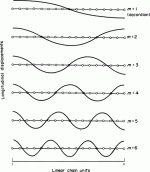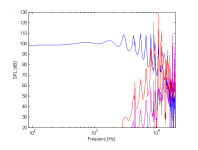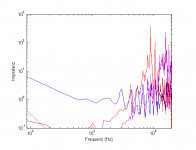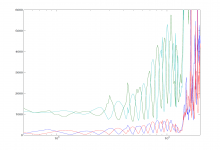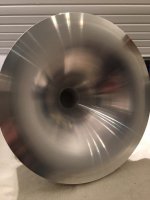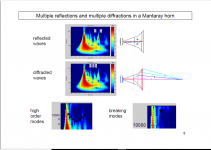"A mode is like an exaggeration (2: to enlarge or increase especially beyond the normal)" to me equals "A mode is like a propagation (2: INCREASE, )"
Last edited:
camplo - you really need to check up your vocabulary and definitions. Thats all I can say... it seems rather confused.
//
//
You are referring to webster's and wiki definitions not mine
Mode | Definition of Mode by Merriam-Webster - b: a particular functioning arrangement
Exaggerate | Definition of Exaggerate by Merriam-Webster - 2: to enlarge or increase especially beyond the normal
Canceling | Definition of Canceling by Merriam-Webster d: to bring to nothingness
Decrease | Definition of Decrease by Merriam-Webster : to grow progressively less
Propagate | Definition of Propagate by Merriam-Webster - 2: INCREASE, EXTEND ----- c: to transmit (something, such as sound or light) through a medium
Sound | Definition of Sound by Merriam-Webster c: mechanical radiant energy that is transmitted
https://en.wikipedia.org/wiki/Sound In physics, sound is a vibration that propagates as an acoustic wave, through a transmission medium such as a gas, liquid or solid.
Resonance - Wikipedia - Resonance describes the phenomenon of increased amplitude that occurs when the frequency of a periodically applied force (or a Fourier component of it) is equal or close to a natural frequency of the system on which it acts.
https://www.merriam-webster.com/dictionary/amplitude a: the extent of a vibratory movement (as of a pendulum) measured from the mean position to an extreme
https://www.merriam-webster.com/dictionary/vibratory 1: consisting of, capable of, or causing vibration or oscillation
Excess | Definition of Excess by Merriam-Webster more than the usual, proper, or specified amount
Decay | Definition of Decay by Merriam-Webster 2: gradual decline in strength
I am literally doing what you say
except for "When something continues to resonate longer than the source I thought it was excess decay" I should say deficit decay...an increase in decay would suggest that decay happens faster not slower... call it decay delay
Mode | Definition of Mode by Merriam-Webster - b: a particular functioning arrangement
Exaggerate | Definition of Exaggerate by Merriam-Webster - 2: to enlarge or increase especially beyond the normal
Canceling | Definition of Canceling by Merriam-Webster d: to bring to nothingness
Decrease | Definition of Decrease by Merriam-Webster : to grow progressively less
Propagate | Definition of Propagate by Merriam-Webster - 2: INCREASE, EXTEND ----- c: to transmit (something, such as sound or light) through a medium
Sound | Definition of Sound by Merriam-Webster c: mechanical radiant energy that is transmitted
https://en.wikipedia.org/wiki/Sound In physics, sound is a vibration that propagates as an acoustic wave, through a transmission medium such as a gas, liquid or solid.
Resonance - Wikipedia - Resonance describes the phenomenon of increased amplitude that occurs when the frequency of a periodically applied force (or a Fourier component of it) is equal or close to a natural frequency of the system on which it acts.
https://www.merriam-webster.com/dictionary/amplitude a: the extent of a vibratory movement (as of a pendulum) measured from the mean position to an extreme
https://www.merriam-webster.com/dictionary/vibratory 1: consisting of, capable of, or causing vibration or oscillation
Excess | Definition of Excess by Merriam-Webster more than the usual, proper, or specified amount
Decay | Definition of Decay by Merriam-Webster 2: gradual decline in strength
I am literally doing what you say
before and now after your post lol and I am reading it but not confused by it....check up your vocabulary and definitions
except for "When something continues to resonate longer than the source I thought it was excess decay" I should say deficit decay...an increase in decay would suggest that decay happens faster not slower... call it decay delay
Last edited:
decay delay - if the signal source was 0, decay delay will be the amount past 0 that has been added or subtracted.....if a mode cancels and increases sound energy the decay delay will change
"If a driver is making sound I call that resonation" - Nope - see above - "... phenomenon of increased amplitude that occurs..."
"The electrical signal oscillates first" Oscillation is Resonance - so no. You dont use the term like that if you are in the trade - it sounds like a beginner is trying...
"How is the transfer of oscillation from one source to the other not resonance and what to call it" - This is 'wave propagation'. Again oscillation is not the proper term for what you are trying to say (I think...)
"When something continues to resonate longer than the source I thought it was excess decay" - Resonance is an unwanted (but OK in instruments) continuation of an excitation of a (one) wave(form). "Excess *decay*" haven't been mentioned here at all - is that even a defined term?
""An HOM is not a resonance but a different way for a resonance to mode"
" - thats a faulty quote - it was not written like that - please check again... where you guessing?
So no, you don't use the websters definitions.
//
"The electrical signal oscillates first" Oscillation is Resonance - so no. You dont use the term like that if you are in the trade - it sounds like a beginner is trying...
"How is the transfer of oscillation from one source to the other not resonance and what to call it" - This is 'wave propagation'. Again oscillation is not the proper term for what you are trying to say (I think...)
"When something continues to resonate longer than the source I thought it was excess decay" - Resonance is an unwanted (but OK in instruments) continuation of an excitation of a (one) wave(form). "Excess *decay*" haven't been mentioned here at all - is that even a defined term?
""An HOM is not a resonance but a different way for a resonance to mode"
" - thats a faulty quote - it was not written like that - please check again... where you guessing?
So no, you don't use the websters definitions.
//
I'm sorry but I am right in this case...you are confusing resonance with decay characteristics
Oscillation | Definition of Oscillation by Merriam-Webster 4: a single swing (as of an oscillating body) from one extreme limit to the other
Each oscillation of the pendulum represents one second.
Resonance | Definition of Resonance by Merriam-Webster (1): a vibration of large amplitude in a mechanical or electrical system caused by a relatively small periodic stimulus of the same or nearly the same period as the natural vibration period of the system
the woofer resonantes the electrical signal
The problem is we (America) uses resonance for two different meanings in sound
Oscillation | Definition of Oscillation by Merriam-Webster 4: a single swing (as of an oscillating body) from one extreme limit to the other
Each oscillation of the pendulum represents one second.
Resonance | Definition of Resonance by Merriam-Webster (1): a vibration of large amplitude in a mechanical or electrical system caused by a relatively small periodic stimulus of the same or nearly the same period as the natural vibration period of the system
the woofer resonantes the electrical signal
this is actually modes and decay delayResonance is an unwanted (but OK in instruments) continuation of an excitation of a (one) wave(form)
The problem is we (America) uses resonance for two different meanings in sound
Last edited:
All is revealed in the success of making one understood. You failed apparently - hence this discussion.. but you seem to suspect it as
"I use the word resonance incorrectly? If a driver is making sound I call that resonation"
//
"I use the word resonance incorrectly? If a driver is making sound I call that resonation"
//
Thats just it....I didn't use it Improperly =)
Sound is resonation ( you admit that here "Oscillation is Resonance"...sound is pressure wave oscillation ....transmitted through the air to your ear)....how long it resonates for is sustain and decay
Oscillation | Definition of Oscillation by Merriam-Webster 4: a single swing (as of an oscillating body) from one extreme limit to the other
Correction; unwanted resonance isn't wanted.... and decay delay isn't wanted
You want the driver to resonate (make sound) but you don't want it to continue resonating (making sound) longer than the signal (decay delay or excess decay delay depending on how you look at it)...you don't want the box to resonate at all...
Musical instruments; a violin? Harmonics are modes...to say the violin enclosure resonates is to say it makes sound...
A propagating mode of sound energy, represents increased sound energy over signal....thus a propagation mode is increased resonation.....
I normally see an increase in decay delay wherever a resonate note (aka propagation mode) is located
You guys do not want Modes in the output....if the reference input is 0....then any modes will be < or > then 0
Sound is resonation ( you admit that here "Oscillation is Resonance"...sound is pressure wave oscillation ....transmitted through the air to your ear)....how long it resonates for is sustain and decay
Oscillation | Definition of Oscillation by Merriam-Webster 4: a single swing (as of an oscillating body) from one extreme limit to the other
"... Resonance is an unwanted
Correction; unwanted resonance isn't wanted.... and decay delay isn't wanted
You want the driver to resonate (make sound) but you don't want it to continue resonating (making sound) longer than the signal (decay delay or excess decay delay depending on how you look at it)...you don't want the box to resonate at all...
Musical instruments; a violin? Harmonics are modes...to say the violin enclosure resonates is to say it makes sound...
A propagating mode of sound energy, represents increased sound energy over signal....thus a propagation mode is increased resonation.....
I normally see an increase in decay delay wherever a resonate note (aka propagation mode) is located
You guys do not want Modes in the output....if the reference input is 0....then any modes will be < or > then 0
Last edited:
Higher frequency carries less decay delay....so a HOM's decay delay is going to be significantly tighter than the tuning note (vent mode) of a vented subwoofer....like super tight I'd guess....so in the CSD youd have to zoom in.....the response before the Horn/waveguide is added is 0 so after the waveguide/horn is placed....literally every change in amplitude you see is a mode (of some kind) lol
the power of linguistics.....
Higher order mode .....Higher order Harmonics to follow?
I was right!
Higher-order Modes
Definition: transverse modes of a resonator or waveguide, excluding the fundamental (axial) modes
I believe you guys are looking at these via location in the polar radiation field...You might have to measure them at their location...
the power of linguistics.....
Higher order mode .....Higher order Harmonics to follow?
I was right!
Higher-order Modes
Definition: transverse modes of a resonator or waveguide, excluding the fundamental (axial) modes
I believe you guys are looking at these via location in the polar radiation field...You might have to measure them at their location...
Last edited:
The tendency of a higher amplitude of resonance (louder) to ring longer (decay delay) is inertia....on every level....mechanical and acoustical (I can't speaker on electrical)
Mode | Definition of Mode by Merriam-Webster - b: a particular functioning arrangement
Propagate | Definition of Propagate by Merriam-Webster - 2: INCREASE, EXTEND ----- c: to transmit (something, such as sound or light) through a medium
Attachments
Introduction
When developing horns for effective midrange/treble reproduction in public address systems, next to the conventional prototype construction, the numerical Simulation with BEM (Boundary Element Method), FEM (Finite Element Method) or similar methods as fast and resource-saving alternative has been established. The application of the well-known four-pole description to the acoustically coupled system horn driver / horn allows both systems at the common interface to separate. Due to the one-dimensional nature of the acoustic distribution, the transition between driver and horn cannot be recorded in general. The applicability of this methodology, based on a wave in transition, has already been shown and statistically secured for one limited frequency range.
The limits of this procedure are particularly evident in the higher frequency range in which the radiation of the systems are dominated by higher modes.
The restrictions due to the quadrupole description around, a modal multi-port should be introduced. The description is then possible in the transition between driver / horn through a system of orthogonal eigenfunctions.
Representation on a modal basis
The sound pressure and possibly the sound velocity in the interface between driver and horn are described as linear combination of basis vectors, from the orthogonal eigenfunctions of the cylindrical tube. The associated participation coefficients are derived from the measured pressure or distribution decomposition. This representation allows a description of the systems regardless of the specific distribution of the measurement positions in the cross section of the driver's exit.
Makarski used a four-pole LTI system for his measurements.
Fig. 1. Fundamental mode of the source pressure (blue) and the first two radial modes.
Fig. 2. Source impedance for fundamental mode (blue) and two radial modes.
Fig. 3. Frequency curve of the four matrix entries of the Four-pole representation of a horn driver.
When developing horns for effective midrange/treble reproduction in public address systems, next to the conventional prototype construction, the numerical Simulation with BEM (Boundary Element Method), FEM (Finite Element Method) or similar methods as fast and resource-saving alternative has been established. The application of the well-known four-pole description to the acoustically coupled system horn driver / horn allows both systems at the common interface to separate. Due to the one-dimensional nature of the acoustic distribution, the transition between driver and horn cannot be recorded in general. The applicability of this methodology, based on a wave in transition, has already been shown and statistically secured for one limited frequency range.
The limits of this procedure are particularly evident in the higher frequency range in which the radiation of the systems are dominated by higher modes.
The restrictions due to the quadrupole description around, a modal multi-port should be introduced. The description is then possible in the transition between driver / horn through a system of orthogonal eigenfunctions.
Representation on a modal basis
The sound pressure and possibly the sound velocity in the interface between driver and horn are described as linear combination of basis vectors, from the orthogonal eigenfunctions of the cylindrical tube. The associated participation coefficients are derived from the measured pressure or distribution decomposition. This representation allows a description of the systems regardless of the specific distribution of the measurement positions in the cross section of the driver's exit.
Makarski used a four-pole LTI system for his measurements.
Fig. 1. Fundamental mode of the source pressure (blue) and the first two radial modes.
Fig. 2. Source impedance for fundamental mode (blue) and two radial modes.
Fig. 3. Frequency curve of the four matrix entries of the Four-pole representation of a horn driver.
Attachments
Last edited:
Definition of inertia
1a: a property of matter by which it remains at rest or in uniform motion in the same straight line unless acted upon by some external force
Definition of momentum
1: a property (see PROPERTY sense 1a) of a moving body that the body has by virtue of its mass (see MASS entry 2 sense 1c) and motion and that is equal to the product of the body's mass and velocity
Definition of amplitude
a: the extent of a vibratory movement (as of a pendulum) measured from the mean position to an extreme
b: the maximum departure of the value of an alternating current or wave from the average value
In order to increase amplitude, velocity has to increase in order to keep frequency unchanged...thus inertia momentum....But I messed up.... PRESSURE *facepalm*
The velocity gets transferred to PRESSURE.....
so
The tendency of a higher amplitude of resonance (louder) to ring longer (decay delay) is inertia..mechanical
The HOM is as a double up (initial signal and reflective) increasing SPL, and that higher amount of energy takes longer to dissipate...
Hypothesis over....
1a: a property of matter by which it remains at rest or in uniform motion in the same straight line unless acted upon by some external force
Definition of momentum
1: a property (see PROPERTY sense 1a) of a moving body that the body has by virtue of its mass (see MASS entry 2 sense 1c) and motion and that is equal to the product of the body's mass and velocity
Definition of amplitude
a: the extent of a vibratory movement (as of a pendulum) measured from the mean position to an extreme
b: the maximum departure of the value of an alternating current or wave from the average value
In order to increase amplitude, velocity has to increase in order to keep frequency unchanged...thus inertia momentum....But I messed up.... PRESSURE *facepalm*
The velocity gets transferred to PRESSURE.....
so
The tendency of a higher amplitude of resonance (louder) to ring longer (decay delay) is inertia....on every level....mechanical and acoustical (I can't speaker on electrical)
The tendency of a higher amplitude of resonance (louder) to ring longer (decay delay) is inertia..mechanical
The HOM is as a double up (initial signal and reflective) increasing SPL, and that higher amount of energy takes longer to dissipate...
Hypothesis over....
Last edited:
It seems M. Makarski uses Kugelwellenhörner for his research work,
which (also) in my view is, physically, the optimal (complete) horn profile.
which (also) in my view is, physically, the optimal (complete) horn profile.
Attachments
Last edited:
No horn profile is optimal if truncated like that. And to me a strongly beaming profile will never be optimal, no matter what.
- Do you know the conclusion of this paper? - AES E-Library >> Do Higher Order Modes at the Horn Driver's Mouth Contribute to the Sound Field of a Horn Loudspeaker?
I think he used 2" drivers/horns exclusively and even there was nothing conclusive about the HOMs influencing the far field. That's still strange.
We definitely need a really bad 2" horn to be checked. It's probably a non-issue with 1" drivers. Or maybe our ears are much more sensitive to this than we think.
- Do you know the conclusion of this paper? - AES E-Library >> Do Higher Order Modes at the Horn Driver's Mouth Contribute to the Sound Field of a Horn Loudspeaker?
I think he used 2" drivers/horns exclusively and even there was nothing conclusive about the HOMs influencing the far field. That's still strange.
We definitely need a really bad 2" horn to be checked. It's probably a non-issue with 1" drivers. Or maybe our ears are much more sensitive to this than we think.
Last edited:
Here we agree.
If he was right it seems that JMLC recognized/detected them in this paper
https://pearl-hifi.com/06_Lit_Archive/14_Books_Tech_Papers/LeCleach_Jean-Michel/Horn_Shootout_ETF2010.pdf
Attachments
I don't think so. He used "HOM" as a joint term for "high order modes + breaking modes + HF resonances of the driver", without even attempting to investigate what are the respective contributions. It's quite possible there were no actual horn HOMs observed - much of what is shown there will still be some other issues, IMO. Also the plots of group delays are pretty meaningless in that report, as we have just discussed here.
BTW, as JMLC states in that report:
"A good horn should provide the less amount of reflected waves, diffracted waves and unwanted high order modes."
- Add "constant directivity" to that list and I would agree.
BTW, as JMLC states in that report:
"A good horn should provide the less amount of reflected waves, diffracted waves and unwanted high order modes."
- Add "constant directivity" to that list and I would agree.
Last edited:
Interesting...I would guess, also that, GD increases as spl goes up, when GD source is acoustic mechanical but, not a filter, and is exaggerated in certain areas, as spl increase....You mentioned inductance modulation...sounds like something tied to the velocity of the drivers movement vs inertia
moving on
----------------------------------------------------------------------------------------------
A mode is like an exaggerated or cancelling resonation isn't? In the CSD wouldn't this show as exaggerated decay or cancelled decay? I believe this HOM discussion is aimed towards horns/waveguides? So direct energy measurement of the bare driver is normal and the direct energy measurement with horn/waveguide attached, is the difference via CSD?
Looking at my own previous tests, it seems to me the modes are hidden in the CSD and quite difficult to see. However, wavelets can show quite clearly the reflection back from the mouth. As Earl also mentioned, modes may not be resonances, which are often also seen in the wavelets plot. One thing I was not able to do at the time of previous testing, was reduce the length of the CSD. For some reason, using a same dome driver with a horn always had a much longer decay time than the clean driver.
I don't think so. He used "HOM" as a joint term for "high order modes + breaking modes + HF resonances of the driver", without even attempting to investigate what are the respective contributions. It's quite possible there were no actual horn HOMs observed - much of what is shown there will still be some other issues, IMO. Also the plots of group delays are pretty meaningless in that report, as we have just discussed here.
BTW, as JMLC states in that report:
"A good horn should provide the less amount of reflected waves, diffracted waves and unwanted high order modes."
- Add "constant directivity" to that list and I would agree.
Constant directivity or not really depends on area of application. For home use, it might be fine. But my experience on a dance floor with speakers mounted up high, this may not be the best solution.
- Home
- Loudspeakers
- Multi-Way
- Acoustic Horn Design – The Easy Way (Ath4)
